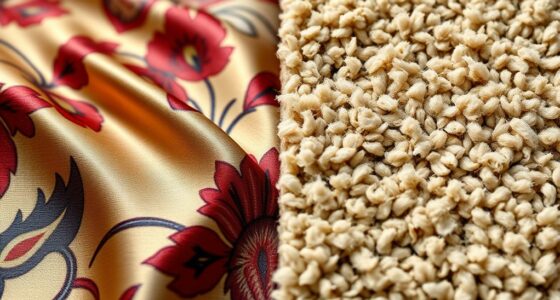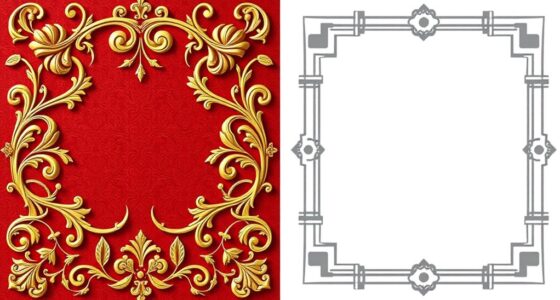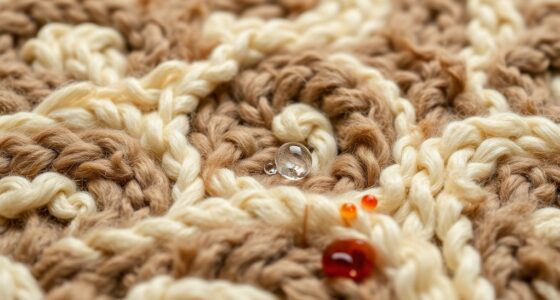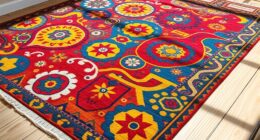Some collectors remove silk backings to better reveal the fabric’s original beauty, colors, and craftsmanship. Removing the backing can enhance the piece’s aesthetic appeal and sometimes increase its value. It also helps preserve the main textile by preventing further deterioration from old adhesives or environmental stress. However, this process requires careful handling to avoid damage. If you want to understand the benefits and challenges involved, there’s more to contemplate as you explore this restoration approach.
Key Takeaways
- Some collectors remove silk backing to reveal the intricate textile layers beneath, enhancing visual detail and fabric texture.
- Removing backing can facilitate cleaning and restoration, especially if adhesive or deterioration threatens the fabric.
- Collectors may opt to remove silk backing to prevent further damage from aging adhesives or environmental factors.
- In certain cases, backing removal allows for better assessment of the textile’s condition and authenticity.
- Preservation standards sometimes favor removing non-original or deteriorated backing to maintain the textile’s overall integrity.
The Aesthetic Appeal of Revealed Fabrics

Have you ever noticed how revealed fabrics can transform the look of a piece? When you see layers of textile dyeing beneath the surface, it adds depth and complexity to the overall aesthetic. Revealed fabrics showcase the artistry behind fabric layering, highlighting how different textures and colors interact. This interplay can create striking visual effects, making each piece unique. The subtle variations in dyeing techniques and fabric combinations often evoke a sense of history and craftsmanship. By exposing these hidden layers, you appreciate the intricate work that went into creating the textile. The aesthetic appeal lies in discovering these details, which can turn a simple piece into a mesmerizing work of art. Revealed fabrics invite you to look closer and enjoy their layered beauty. Additionally, understanding the regional textile traditions can deepen your appreciation for the craftsmanship involved. Recognizing the dyeing techniques used in different regions can also enhance your overall understanding of textile artistry, especially when considering the traditional methods that influence contemporary designs. Exploring the fiber qualities can further reveal why certain textiles age beautifully and how their tactile qualities add to their visual appeal. Moreover, examining the fabric construction can provide insight into the durability and unique textures that contribute to the fabric’s character over time.
Preservation and Longevity of the Main Textile
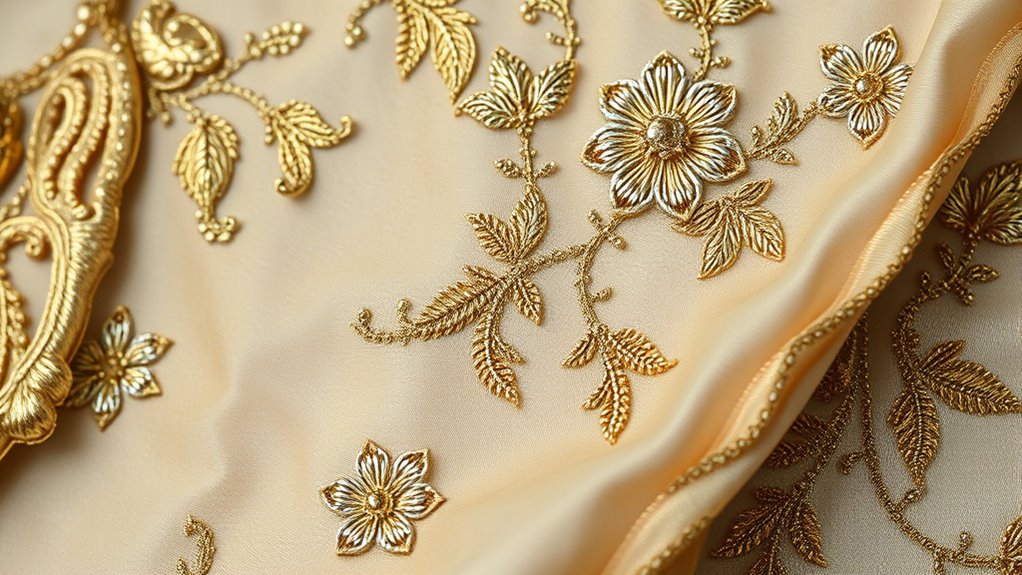
To guarantee the main textile remains durable and retains its beauty over time, proper preservation techniques are essential. You should handle the fabric gently, avoiding unnecessary stress that can cause damage. Regularly store it in a clean, dry environment away from direct sunlight, which can fade colors. When needed, consult professional conservators who use appropriate restoration techniques that respect the integrity of the textile, adhering to conservation ethics. These ethics emphasize minimal intervention and reversible processes to preserve historical authenticity. Avoid over-cleaning or harsh chemicals that might weaken fibers. Instead, focus on stable storage conditions and gentle cleaning methods. Additionally, participating in hackathons can foster innovative approaches to textile preservation technology, potentially leading to new conservation solutions. For example, developing advanced storage materials can help protect textiles from environmental damage. Staying informed about material science advancements can further enhance preservation strategies. Incorporating digital documentation techniques can also assist in monitoring the condition of textiles over time. By following these guidelines, you help ensure the textile’s longevity while maintaining its historical and aesthetic value for future generations.
Addressing Damage and Deterioration Risks

To safeguard your silk backing fabrics, it’s crucial to prevent decay and minimize exposure to harmful conditions. Regularly inspect your textiles for signs of deterioration and maintain stable humidity levels to avoid mold growth. Taking these steps helps ensure your fabrics stay vibrant and intact for years to come. Additionally, controlling indoor air quality can significantly reduce the buildup of pollutants that might accelerate fabric degradation. Using air purifiers with HEPA filtration can help remove allergens and pollutants from the air, further protecting delicate textiles. Ensuring proper ventilation can also help in reducing stagnant air and moisture buildup around your fabrics, which is essential for preventing mold growth. Maintaining a consistent temperature can also help preserve the integrity of silk fabrics and prevent thermal damage.
Preventing Fabric Decay
Preventing fabric decay starts with understanding the factors that cause damage and deterioration. You need to be aware of environmental conditions like humidity, light, and pollutants that accelerate deterioration. Proper storage and display are vital to avoid exposure to harmful elements. When addressing restoration challenges, make certain that any repairs use materials compatible with the original silk backing. Incompatible materials can worsen decay or cause further damage over time. Regular inspections help catch early signs of deterioration, allowing you to intervene before irreversible damage occurs. Maintaining a stable environment and carefully selecting restoration techniques will extend the fabric’s lifespan. Additionally, incorporating protective styling techniques can reduce physical wear on the fabric, helping to preserve its integrity over time. Understanding the importance of environmental control is essential for long-term preservation. Recognizing the role of environmental factors in fabric decay can guide more effective preservation strategies. By understanding these factors, you can better protect your silk backing fabrics from decay and preserve their historical and aesthetic value.
Reducing Mold Risks
Since mold thrives in damp and stagnant conditions, controlling moisture levels is essential for reducing its risk. You should regularly check your textiles for any signs of moisture and ensure proper ventilation. Applying a chemical treatment can help inhibit mold growth, especially on silk backing fabrics. Consider using backing reinforcement to provide extra stability, which can reduce the fabric’s susceptibility to mold-causing damage. Keep storage areas dry and maintain consistent temperature and humidity levels. When cleaning, avoid excess moisture and opt for gentle methods. Removing silk backing fabrics isn’t always necessary, but if mold persists or damage worsens, replacing or treating the backing with appropriate chemicals can markedly extend the fabric’s lifespan. Precise moisture control is your best defense against mold deterioration. Implementing AI analytics can also help monitor environmental conditions more effectively, ensuring optimal storage environments.
Enhancing the Value of Vintage Pieces
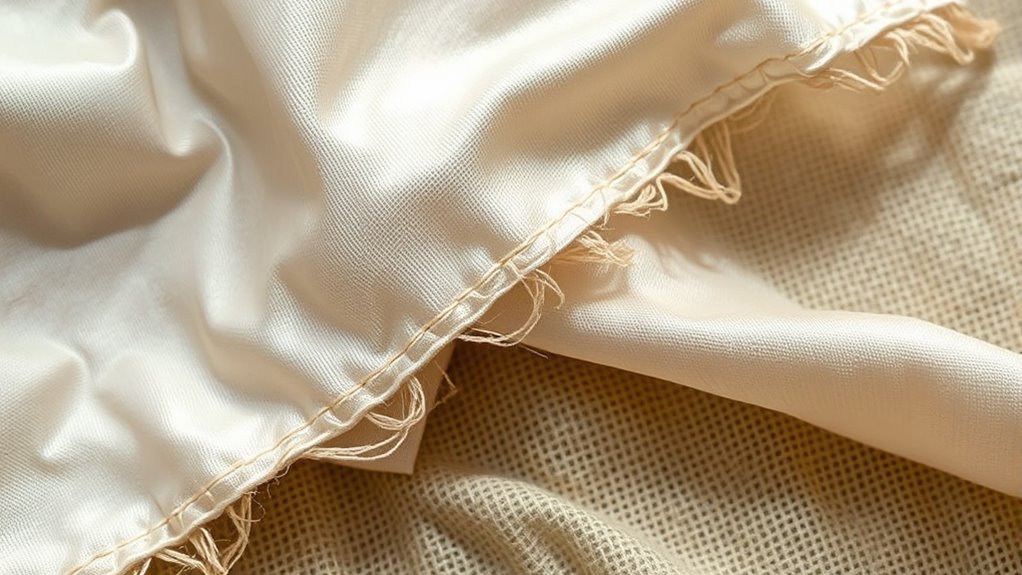
You can boost the worth of vintage pieces by carefully preserving their original details, ensuring their authenticity stays intact. Improving their visual appeal through subtle restorations or cleanings can also attract more interest. When you focus on these aspects, you maintain both the historical value and aesthetic charm that collectors cherish.
Preserving Authenticity and Value
Maintaining the authenticity and value of vintage fabrics with silk backing requires careful attention and expert handling. Modern manufacturing has introduced synthetic fibers that can mimic silk but often lack the same historical significance. Removing silk backing without proper expertise risks damaging the original fabric and diminishing its worth. To preserve authenticity, you should avoid aggressive cleaning or restoration techniques that alter the fabric’s original state. Instead, focus on gentle preservation methods that respect the vintage piece’s age and craftsmanship. Keeping the silk backing intact, when appropriate, maintains the piece’s provenance and collectible value. By understanding the materials and their history, you ensure your vintage fabrics retain their appeal and worth for future appreciation.
Enhancing Visual Appeal
Enhancing the visual appeal of vintage fabrics with silk backing can substantially increase their desirability and market value. By carefully addressing restoration challenges, you can highlight the fabric’s original beauty, aligning with collector preferences for authenticity. Imagine a piece with vibrant colors, intricate patterns, and a smooth silk backing that enhances its texture. Such improvements make the item stand out in any collection. Visual enhancements might include:
- Restoring faded hues to their original brilliance
- Removing discoloration or stains discreetly
- Repairing tears without compromising integrity
- Reattaching loose or damaged silk backing
- Highlighting fine details with subtle cleaning techniques
Focusing on these aspects appeals to collectors who prioritize both aesthetic appeal and authenticity, ultimately boosting the vintage piece’s value.
Authenticity and Historical Accuracy
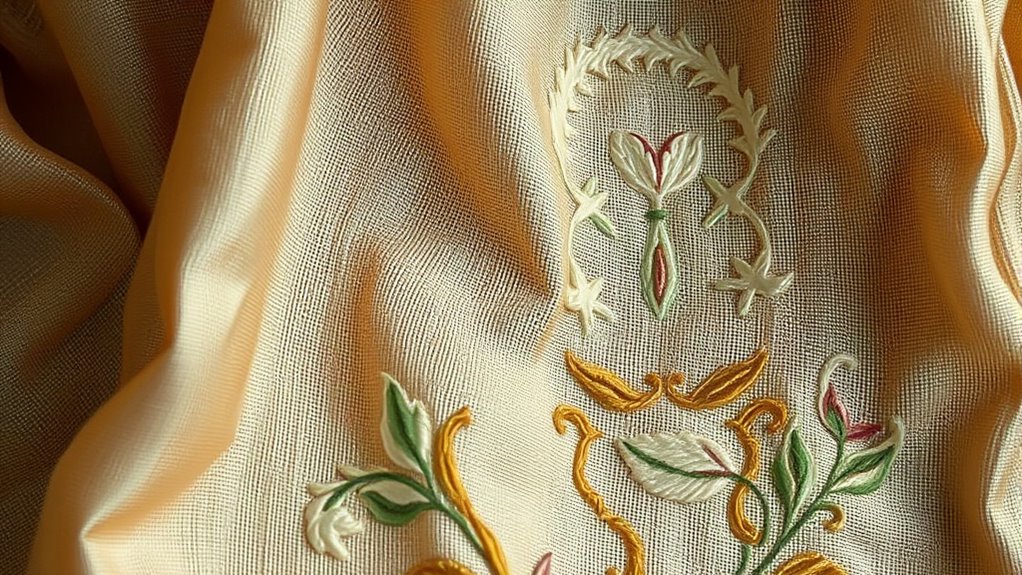
Ensuring the authenticity and historical accuracy of silk backing fabrics is essential for preserving their cultural significance and value. You should be aware that restoration techniques can impact how true a piece remains to its original state, which many collectors prioritize. To maintain authenticity, avoid altering or replacing backing fabrics unless absolutely necessary, and document any interventions thoroughly. Understanding collector preferences helps guide decisions—some value original backing for its historical integrity, while others accept discreet restoration. When evaluating a textile’s authenticity, consider provenance, craftsmanship, and fabric age. Being meticulous about these elements not only preserves the piece’s integrity but also enhances its worth. Ultimately, respecting historical accuracy ensures your collection reflects genuine craftsmanship and cultural heritage.
Challenges of Maintaining Backed Textiles
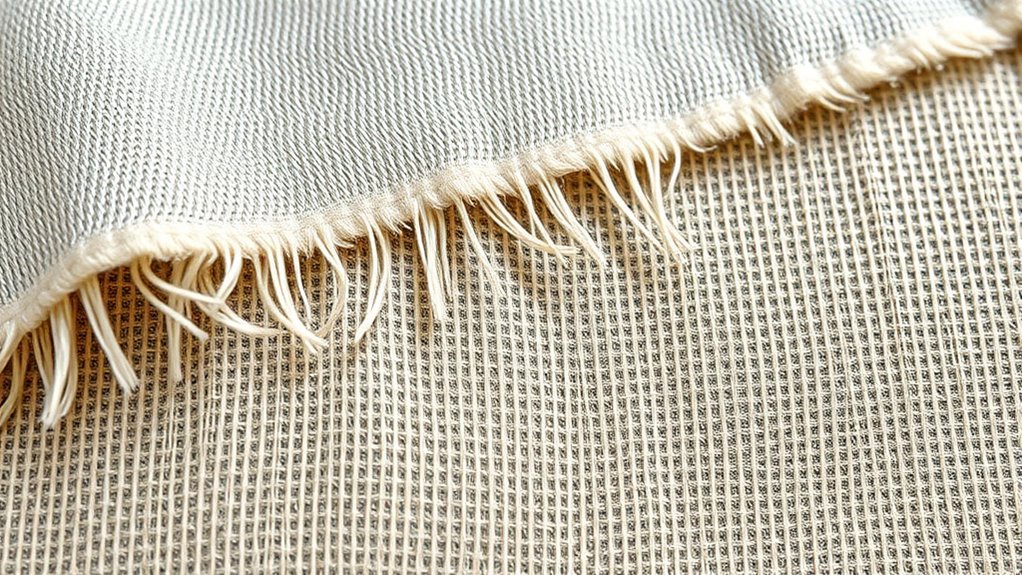
Backed textiles face a range of challenges that threaten their stability and longevity. Over time, adhesives can yellow, crack, or cause the fabric to warp, making preservation difficult. You must carefully decide when to use restoration techniques to stabilize the textile without damaging it. Removing old adhesive is especially tricky, as improper adhesive removal can tear or weaken the fabric. Environmental factors like humidity, light, and pests also accelerate deterioration, compounding these issues. Visualize the risks:
- Cracked or brittle backing material
- Discolored, aged adhesives
- Warped or distorted fabric
- Loss of original texture and color
- Increased fragility from improper handling
Handling these challenges requires precision, patience, and expertise to maintain the textile’s integrity while addressing backing-related issues.
Techniques and Considerations for Removal
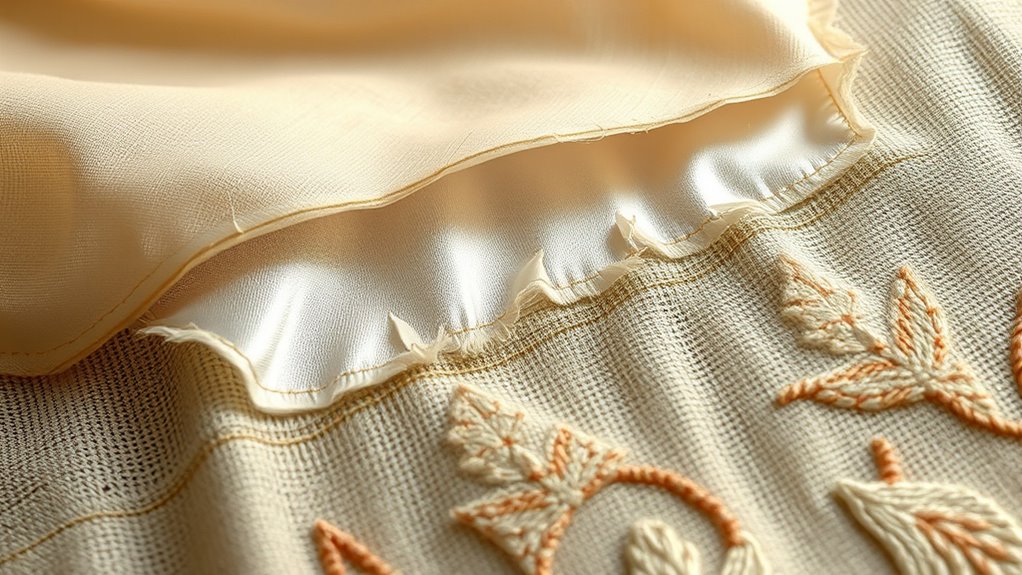
Removing old adhesives from backed textiles requires careful planning and precise techniques to avoid damaging the fragile fabric. You should start by evaluating the type of adhesive and backing material, as different methods work best for specific scenarios. Gentle heat, such as a low-temperature heat gun or a damp cloth, can soften adhesives for easier removal. Mechanical tools like scalpels or tweezers may help lift residues carefully. Keep in mind the cost considerations—professional conservation services might be expensive but ensure safe removal without risking damage. Consulting with an expert is highly recommended, especially if the textile is valuable or delicate. They can guide you on the safest methods and help evaluate whether removal is feasible without compromising the item’s integrity.
Frequently Asked Questions
How Does Backing Removal Affect a Textile’S Structural Integrity?
Removing backing from a textile can impact its structural stability, especially if the backing provides support. It may weaken the fabric, making it more fragile and prone to damage during handling or display. For fabric preservation, it’s important to contemplate how backing removal affects the overall integrity of the piece. While it might improve appearance, it can compromise the textile’s long-term durability and structural stability.
Are There Specific Tools Recommended for Safely Removing Silk Backing?
If you’re considering removing silk backing, you’ll want specialized tools designed for delicate work. Using gentle techniques with fine-tipped tweezers, scalpel blades, or small brushes helps prevent damage. Think of it as a careful art; these specialized tools let you peel away the backing slowly and precisely, ensuring the textile’s integrity stays intact. This approach minimizes risk and makes the removal process safer and more controlled.
What Are the Signs Indicating a Textile’S Backing Needs Removal?
You should consider removing the backing if you notice detachment signs like peeling, cracking, or bubbling. Backing deterioration, such as fraying or mold, also indicates it’s time for removal. These issues can threaten the textile’s integrity and appearance. Acting promptly helps preserve the piece, so regularly inspect your textiles for these signs, and if you spot them, carefully plan a professional removal to prevent further damage.
Can Backing Removal Be Reversed or Repaired if Damaged?
When considering backing removal, you wonder if it can be reversed or repaired if damaged. Restoration possibilities depend on the extent of damage, so you should first conduct a damage assessment. If the backing is delicate or compromised, a professional conservator can often stabilize or repair it. Keep in mind that some damage may be irreversible, so consulting an expert ensures you make informed decisions about preserving your textile’s integrity.
What Are the Legal or Ethical Considerations in Removing Backing Fabrics?
When you consider removing backing fabrics, you must weigh cultural preservation and legal restrictions. You might feel tempted to restore or preserve an item, but you should respect its historical integrity and adhere to laws protecting artifacts. Removing backing fabrics without proper authorization can damage cultural significance, violate legal restrictions, and threaten ethical standards. By honoring these considerations, you help preserve history, uphold integrity, and avoid potential legal repercussions.
Conclusion
If you’re passionate about preserving the true beauty of vintage textiles, removing silk backing might be your secret weapon. It’s like peeling back layers of history to reveal a masterpiece beneath, transforming your collection into a timeless treasure. Just remember, this task requires care and patience—otherwise, you risk turning a delicate gem into a brittle relic. With the right approach, you’ll guarantee your fabrics shine brighter than ever, truly outshining even the most dazzling jewels.


